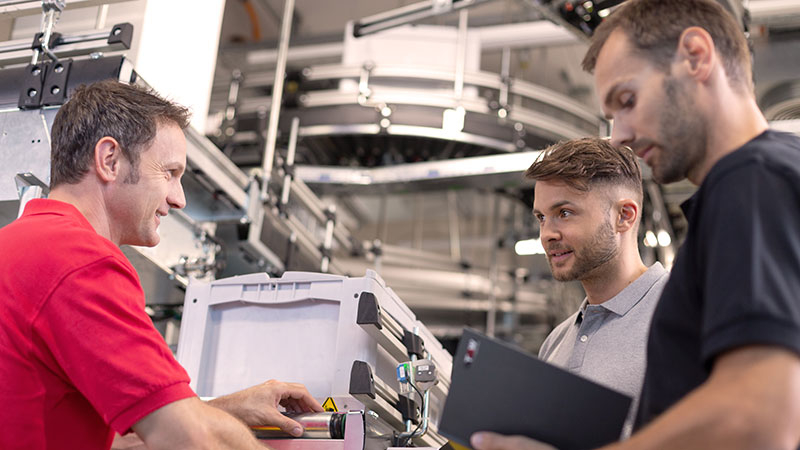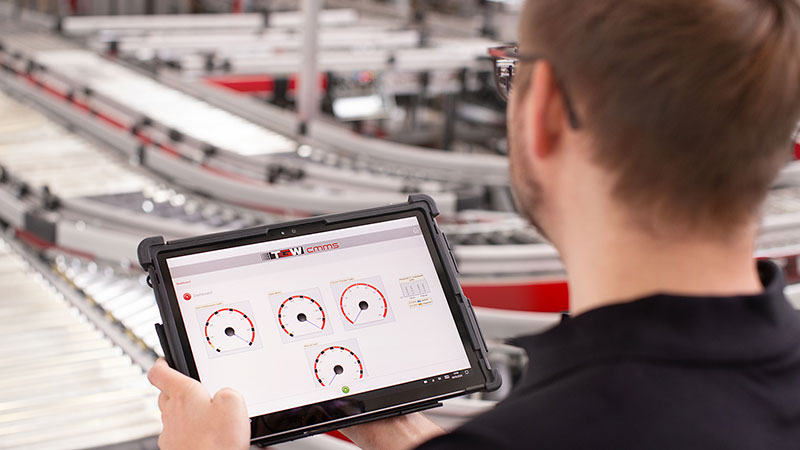- Success factors in retrofit projects
- Companies placing increased value on sustainability and saving energy
- Step-by-step approach becoming more popular than big bang approach
- Interview with Markus Kammerhofer, Head of Retrofit Sales
(Marchtrenk, 10 June 2021) The corona pandemic and the establishment of resilient supply chains are driving the demand for retrofit soultions in the material handling inudstry. In an interview, Markus Kammerhofer, Head of Retrofit Sales at the TGW Logistics Group, outlined how projects can be successfully carried out and how much lead time one should allow.
Intralogistics systems made of steel and iron are durable. How long after putting a system into operation does it make sense to carry out a retrofit?
Markus Kammerhofer: Steel and iron are indeed durable, and some intralogistics systems have been running for decades. When it comes to retrofitting, however, the main concern is not replacing sturdy steel components. Bringing the IT and control systems up to date is important and should be on the agenda every few years, particularly in growing companies. A retrofit primarily involves modifying and expanding material flow systems to allow the system operator to optimally address their customers' needs. Basically, I would divide retrofit activities into three subcategories.
What are they?
Firstly, adjustments that often need to be made within months of a system being put into operation in order to keep up with new market requirements in these fast-moving times. The second category encompasses expansions that become necessary a few years after go-live, particularly in companies with a high growth rate. The third category consists of modernising the IT and control systems; on average, this becomes necessary every four or five years. It's not the mechanical equipment's turn until ten or more years have gone by. When updating the software to the current state-of-the-art, you should consider doing the same for the control system.
How is the market developing?
Retrofit is a growth market. At TGW we're handling almost five times as many retrofit projects annually as we were ten years ago. This is due on the one hand to the fact that we have sold so many new installations during that time. On the other hand, companies are becoming increasingly aware that they will only get ahead of the competition if they perfectly adapt to their customers' needs. System operators also recognise that keeping delivery promises, and thus establishing a resilient supply chain, is becoming more and more important. The decision-makers are mindful of the so-called VUCA world, that is, of challenges related to Volatility, Uncertainty, Complexity and Ambiguity. Last but not least, the corona pandemic has been driving the market for the past year, as seen for example in the abrupt rise of e-commerce in some sectors.

Why does a retrofit make sense?
There used to be systems operators who went by the motto "never touch a running system." But now practically everyone knows that you have to try to get the most out of intralogistics. Companies can't afford inefficiencies, let alone standstills, and long throughput times are a competitive disadvantage in the world of high-performance logistics.
When is a modernisation project absolutely essential?
If you wait too long, there is a danger that spare parts will run out or that technology will no longer be available. An even bigger concern is the dearth of expertise, for example when IT or controls specialists retire. Today, many IT specialists are proficient in NET, C#, JAVA or SAP, but are lost when it comes to C++ or C. A fundamental part of our retrofit projects is adopting the newest technology, keeping it up to date for as long as possible.

How long does a modernisation project take?
There are two basic options: the "big bang" or a step-by-step approach. The latter has become increasingly relevant because companies do not want to run the risk of something going wrong with the big bang approach. Additionally, fewer and fewer companies take plant holidays, meaning that the system has to run with as few interruptions as possible. We have customers who generate several million Euros of revenue in a single day at a central warehouse. In such a case, every hour that the intralogistics system is at a standstill matters. Such companies stretch modernisation projects out over half a year or longer and we work on the system while it's running, with extensive preparation, of course. Small retrofits can be accomplished over just a few weekends.
What are the most important steps in a project?
Exact analyses and perfect, detailed planning are essential. First we analyse the current state of the technology and the on-site conditions and look at the customer's requirements. Creating a functional specification is obligatory. The existing system's documentation can serve as the basis for the new process description. If the material flow systems have to be replaced, then you also have to be mindful of the interfaces with the subordinate systems: the programmable logic controller, or PLC for short. In any case, you have to develop a well-wrought changeover plan in order to ensure goods availability.
What are the most important advantages of retrofits?
Just upgrading the software to the current state-of-the-art increases functionality. New warehouse management systems enable better connectivity with other systems, such as manufacturing execution systems, supply chain management systems and enterprise resource planning systems, allowing for a more continuous data flow. The goal is always the real-time exchange of information along the value added chain. That is a prerequisite for companies to be able to control their sourcing and material flow as efficiently as possible across companies. More and more often we are being asked if autonomous technologies such as automated guided vehicles or robots can be integrated into the overall system. They offer more flexibility and easier scalability. State-of-the-art warehouse management systems also have the option of touchscreen controls. Their operation is intuitive, employee training simple. This is also true of the system visualisation's continuous zoom option. Users can zoom in down to the system's sensor level to find defective components, for example. Generally speaking, maintenance is also easier after a retrofit because modern components have been incorporated into the system. But there's one thing that will become ever more important...

What is that?
That the end customer's wishes are fulfilled faster than the competition can fulfil them. If you cannot meet new needs, you lose customers. For example: in the past, a customer would be satisfied with one delivery containing 100 order lines. Today, that customer wants the same volume delivered to ten different places, at ten different times. Why? Because that is common practice in big B2C platforms and the customer wants to take advantage of that flexibility in their own company. That's why the system operator has to look at the big picture, and in that case investing in a retrofit quickly pays off.
How sustainable is a retrofit in terms of resources and saving energy?
Generally speaking, retrofits are inherently sustainable investments because they not only extend the lifespan of a company's systems but also increase the company's efficiency. Many companies have set up programmes aimed at reducing their emissions over the coming years. They are conscientious about resources and carefully and thoroughly examine every link in their supply chain to find out where they could cut down on emissions. They particularly appreciate that our newest storage and retrieval machines and our KingDrive® conveyor systems are especially energy efficient.
What are the most important success factors in a project?
Alongside experienced project managers, a structured plan and a functional specification, defining the migration phases is definitely an important success factor. Additionally, our employees need to be well trained to work on-site with the people who have their fingers on the system's pulse. Another important factor is choosing the right moment for a retrofit. If companies assume they can wait until their systems are approaching the breaking point before thinking about it, they are sorely mistaken. You have to consider that the lead time for a project can be up to a year. That is why we approach the customer when their system has reached 85 percent capacity: so that we can develop a solution together that will afford the desired benefits in good time. TGW also makes sure our retrofit specialists are well-trained and continue building their expertise on the job. Furthermore, we rely on products that are specially designed for retrofits.
How much can one expect to invest in a retrofit?
Some projects start at 50,000 Euros, while large projects can cost several million. What you need to consider is: for a company that generates several million Euros of revenue in a day at a central warehouse, for example, a single day with the systems down would cost them more than a retrofit project.
Mr Kammerhofer, thank you for the interview.




